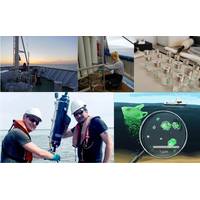
Nanoplastics Abound in the North Atlantic
The total amount of plastic floating in the North Atlantic Ocean as particles of less than 1 micrometer each is estimated at 27 million tons, according to a study by the Royal Netherlands Institute for Sea Research (NIOZ) and Utrecht University.The results were published 09 July 2025 in the scientific journal Nature.For this research, Utrecht master student Sophie ten Hietbrink worked for four weeks aboard the research vessel RV Pelagia. On a trip from the Azores to the continental shelf of Europe, she took water samples at 12 locations where she filtered out anything larger than one micrometer.

Plymouth Marine Lab: Study Shows Benefits of Cross-Country Plastic Pollution Management
tons of plastic that enters the global ocean annually, threatening marine ecosystems and biodiversity worldwide.Using data on plastic emitted via rivers with models of the ocean and atmosphere circulation, the authors simulated the movement and spatial distribution of plastic in and around the North Atlantic Ocean. These simulations were used to estimate the contribution of each country to the stock of plastic in the territorial waters of all other countries.The team then combined the results of the ocean modeling with economic valuation and game-theoretic analysis to assess the benefits of cooperation

2024 was Hottest Year on Record
for July 2024, have exceeded the 1.5°C level.A new record high for daily global average temperature was reached on 22 July 2024, at 17.16°C.2024 was the warmest year for all continental regions, except Antarctica and Australasia, as well as for sizeable parts of the ocean, particularly the North Atlantic Ocean, the Indian Ocean, and the western Pacific Ocean.Each month from January to June 2024 was warmer than the corresponding month in any previous year on record. Each month from July to December, except August, was each the second warmest, after 2023, for the time of year. August 2024 was tied

The Barrier Reef is Still in Hot Water
;re trapping more heat, of which 90% goes into the oceans. Antarctic sea ice is not reforming as it should after last summer. Coral restoration efforts in the United States had to literally pull their baby corals out of the sea to try to keep them alive, as the water was too hot to live in.The North Atlantic Ocean is far warmer than it should be, amid a record-breaking northern summer. After the equinox next month, it will be our turn to face the summer sun once more.Is the Great Barrier Reef in danger? Of course it is. We should not pretend things are normal and can be handled routinely. This year

Minesto's Dragon 12 Project Powers Forward with Cable Installation Completion
Minesto said Wednesday it had successfully completed the first phase of Dragon 12 (1.2 MW) offshore installation in Vestmanna, Faroe Islands. The 3.4 km main subsea cable was laid on the seabed, from the onshore grid connection point to the offshore installation node. After transit across the North Atlantic Ocean to Vestmanna, the cable installation work kicked off and was completed Wednesday. The cable installation was completed in a 22-hour operation. “This cable is the highest valuable component of the infrastructure, and it’s a major milestone to have it safely installed. The installati

Scientists Find Rare Window Where Carbon Sinks Quickly Into the Deep Ocean
shows that carbon dioxide produced by human activities is making its way into the deep ocean. One way is through chemistry: Carbon dioxide dissolves in water, creating carbonic acid. Living creatures in the ocean are another.A view into the Drake PassageOceanographers have long pointed to the north Atlantic Ocean and the Southern Ocean as places where surface waters are moved to depth, taking large volumes of carbon with them. However, recent work has shown that this process may actually be dominated by only a few areas – including the Drake Passage.Despite its being one of the most famous stretches

Inmarsat Provides Connectivity for OceanGate's 2021 Titanic Survey Expedition
Expedition was connected by Inmarsat’s satellite communications. Inmarsat kept the OceanGate Expeditions crew connected with team members and support services during the six-week expedition to document the maritime heritage site located over 400 miles off the coast of Newfoundland in the North Atlantic Ocean.“The OceanGate Expeditions’ Titanic Survey Expedition has taken Inmarsat full circle,” said Eric Griffin, VP Offshore and High End Fishing, Inmarsat. “In response to the sinking of the Titanic and the appalling loss of life, the 1914 Safety of Life at Sea (SOLAS) Convention

A Net-zero Future Depends on the Ocean’s Ability to Absorb Carbon
(the tiny plants and animals that feed everything from mussels to whales) store carbon, so their behaviour and biology become a critical factor in the climate discussion.We urgently need better observations of the ocean’s continued role as our heat and carbon sink.Shifting carbon sinkThe North Atlantic Ocean is the most intense carbon sink in the world: 30 per cent of the global ocean’s carbon dioxide removal occurs right in Canada’s backyard. If we extend Canada’s net-zero calculation to our exclusive economic zone (waters within 200 nautical miles of our coast), our net carbon

Kraken Robotics Wraps Third OceanVision Survey Campaign
and imaging the seabed in and around Atlantic Canada at resolutions never before seen. "The KATFISH system continues to produce excellent results and astounding images. I was especially pleased to see the successful real-world testing of our ALARS system. Sea conditions in October in the North Atlantic Ocean are far from ideal, and the combination of the ALARS and the Tentacle Winch allowed our team to safely and efficiently launch and recover the KATFISH, minimizing risk to personnel and to equipment, and significantly increasing our operational envelope.”“Kraken looks forward to
 December 2025
December 2025





